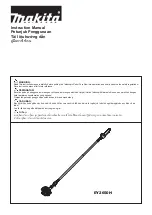
16
TABLE SAW OPERATION
Warning!
Never attempt freehand cuts on this
machine.
Always use the appropriate guide or fence to minimise
the possibility of the blade binding and kickback.
We recommend that the saw blade protrudes through
the material to be cut by approximately 3mm. Adjust
the height of the blade as previously described. This
machine is not suitable for cutting rebates or stopped
grooves.
A vacuum cleaner or workshop dust extraction device
can be connected to the extraction port found at the
rear of the machine if required.
MAKING A RIP CUT (FIG.29)
Set the blade to the correct depth for the workpiece.
Position the rip fence at the desired distance from the
blade for the cut and securely lock the handle.
Make sure the wood is clear of the blade before
turning on the saw.
When ripping a long workpiece, place a support at the
same height as the table surface behind the saw for
the cut work.
Turn the saw on.
Position the workpiece flat on the table with the edge
flush against the rip fence. Let the blade build up to
full speed before feeding the workpiece into the blade.
Once the blade has made contact with the workpiece,
use the hand closest to the rip fence to guide it. Make
sure the edge of the workpiece remains in solid
contact with both the rip fence and the surface of the
table. If ripping a narrow piece, use a push stick
and/or push blocks to move the piece through the cut
and past the blade.
When the cut is made, turn the saw off. Wait for the
blade to come to a complete stop before removing
the workpiece.
MAKING A MITRE CUT (FIG.30)
Remove the rip fence.
Set the blade to the correct depth for the workpiece.
Set the mitre gauge to the desired angle and tighten
the lock knob.
Make sure the wood is clear of the blade before
turning on the saw.
Turn the saw on.
Let the blade build up to full speed before moving the
workpiece into the blade.
Hold the workpiece firmly with both hands on the
mitre gauge and feed the workpiece into the blade.
NOTE: The hand closest to the blade should be
placed on the mitre gauge lock knob and the hand
farthest from the blade should be placed on the
workpiece.
When the cut is made, turn the saw off. Wait for the
blade to come to a complete stop before removing
the workpiece.
MAKING A BEVEL CROSS CUT (FIG.31)
Remove the rip fence.
Unlock the bevel locking knob.
Adjust the bevel angle to the desired setting.
Lock the bevel locking knob.
Set the blade to the correct depth for the workpiece.
Set the mitre gauge to 0° and tighten the lock knob.
Make sure the wood is clear of the blade before
turning on the saw.
Turn the saw on.
Let the blade build up to full speed before moving the
workpiece into the blade.
Hold the workpiece firmly with both hands on the
mitre gauge and feed the workpiece into the blade.
NOTE: The hand closest to the blade should be
placed on the mitre gauge lock knob and the hand
farthest from the blade should be placed on the
workpiece.
When the cut is made, turn the saw off. Wait for the
blade to come to a complete stop before removing
the workpiece.
MAKING A COMPOUND CUT (FIG.32)
Remove the rip fence.
Unlock the bevel locking lever.
Adjust the bevel angle to the desired setting.
Lock the bevel locking lever.
Set the blade to the correct depth for the workpiece.
Set the mitre gauge to the desired angle and tighten
the lock knob.
Make sure the wood is clear of the blade before
turning on the saw.
Turn the saw on.
Let the blade build up to full speed before moving the
workpiece into the blade.
Hold the workpiece firmly with both hands on the
mitre gauge and feed the workpiece into the blade.
NOTE: The hand closest to the blade should be
placed on the mitre gauge lock knob and the hand
farthest from the blade should be placed on the
workpiece.
Summary of Contents for 502241745
Page 2: ...2 1 12 3 4 6 7 1 2 10 14 13 8 11 9 16 15 1B 17 19 20 5 18...
Page 3: ...3 1C 22 21 2 3 4 5...
Page 4: ...4 6 7 8 9 10 11 12 13 max 3 5mm...
Page 5: ...5 14 15 16 17 18 19 20 21 A...
Page 6: ...6 22 23 24 25 26 27 28 29...
Page 7: ...7 30 31 32 33 34 35 36 37...
Page 89: ...89 EN 847 1...
Page 90: ...90 FXA...
Page 91: ...91 1 3...
Page 92: ...92 1 2...
Page 93: ...93 3 4 5...
Page 95: ...95 9 10 11 12 13 14 15 16 17 18 I...
Page 96: ...96 0 18 18 A 5 3 18 6 35 19 20 90 45 90 0 45 45 21 22 23 24 90 60 25 26 27 28...
Page 97: ...97 3 29 30 31 0 32...
Page 98: ...98 33 7 5 90 34 35 36 37 FXA...
Page 100: ...100...
Page 101: ...101 WEEE...
Page 102: ...102...
















































